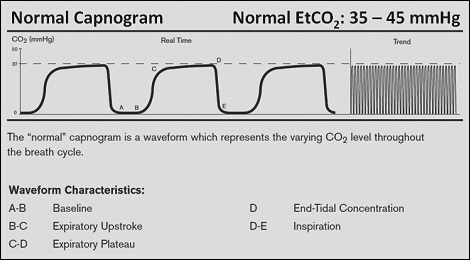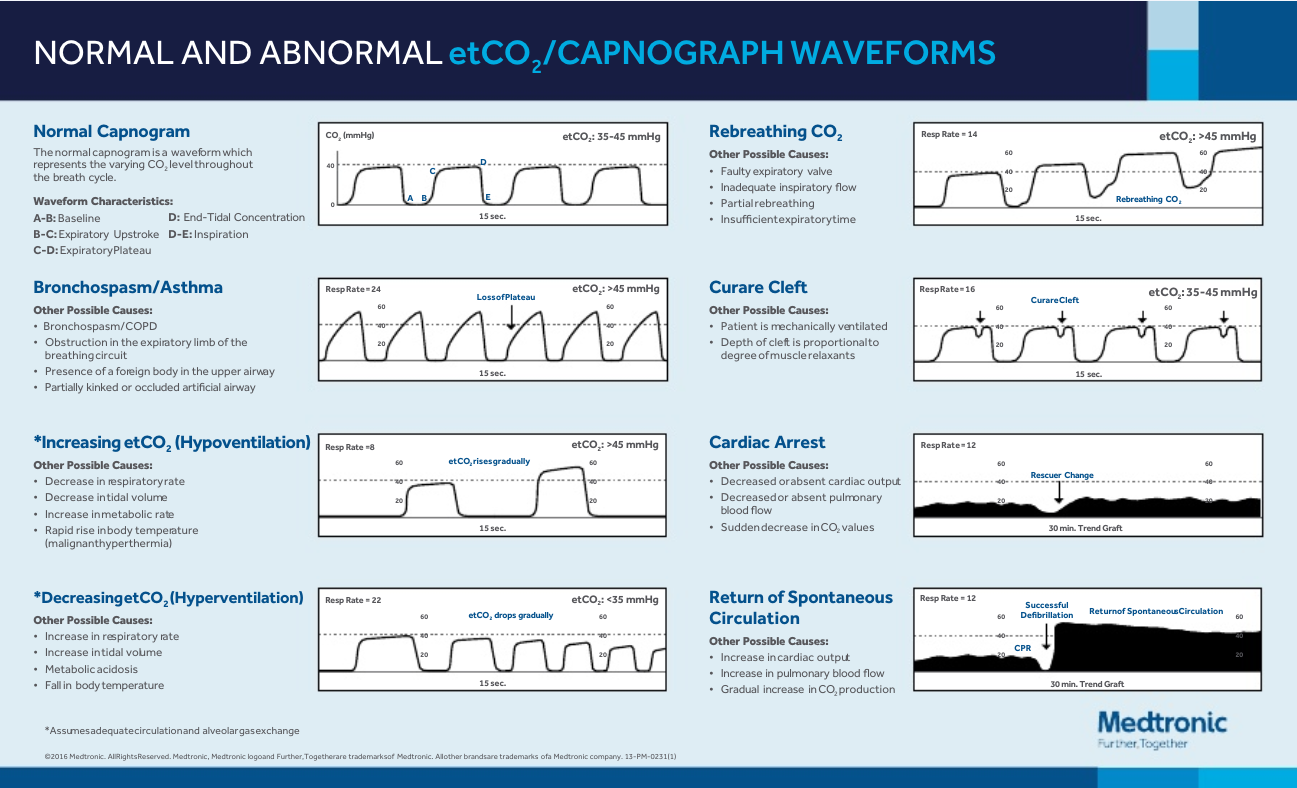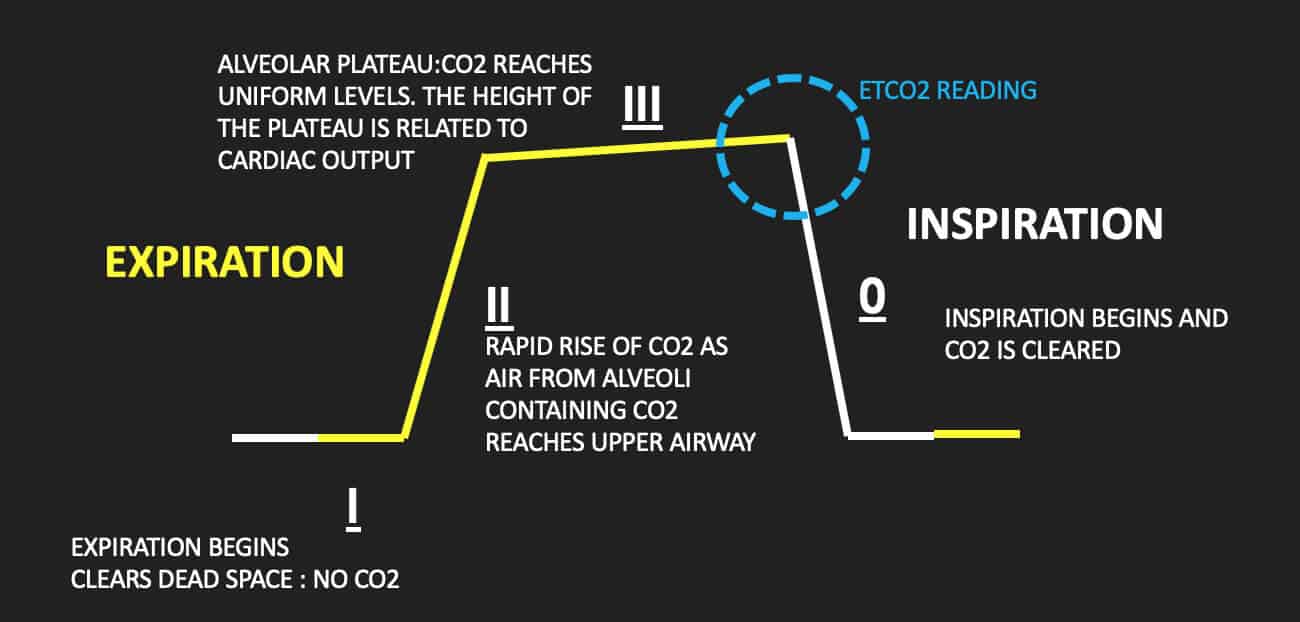normal end tidal co2 levels
More Than Just a Number. End-tidal CO2 EtCO2 monitoring is a noninvasive technique which measures the partial pressure or maximal concentration of carbon dioxide CO2 at the end of an exhaled breath which is expressed as a percentage of CO2 or mmHg.

Figure 1 From Applications Of End Tidal Carbon Dioxide Etco2 Monitoring In Emergency Department A Narrative Review Semantic Scholar
Available evidence has established that ETCO2 measurement can provide an indication of cardiac output and pulmonary blood flow24 Non.

. End-tidal carbon dioxide ETCO2 is the level of carbon dioxide that is released at the end of an exhaled breath. In the awake adult normal cardiac index lies between 25-4 Lminm2 with an ETCO2 of 35-45 mmHg. Agreement between PCO2 and ETCO2 measurements was 84 mmHg and a precision of 111 mmHgAs there is only a moderate correlation between PCO2 and ETCO2 levels in COPD.
End-tidal capnography or end-tidal CO2 EtCO2 monitoring is a non-invasive technique that measures the partial pressure or maximal concentration of carbon dioxide CO2 at the end of an exhaled breath. Changes in end. A retrospective study has shown lesser days of hospital stay in patients with increased levels of intra-operative end-tidal carbon dioxide ETCO 2It is probable that hypercapnia may exert its beneficial effects on patients outcome through optimization of global hemodynamic and tissue oxygenation leading to a lower rate of post-operative.
CO2 is a byproduct of cellular metabolism which gets transported in the blood to the lungs for elimination. The normal values are 5 to 6 CO2 which is equivalent to 35-45 mmHg. For a person with normal lungs the difference between end tidal and Paco2 can vary between 5-8mmHg depending on the book your reading.
End-tidal CO2 EtCO2 monitoring is a noninvasive technique which measures the partial pressure or maximal concentration of carbon dioxide CO2 at the end of an exhaled breath which is expressed as a percentage of CO2 or mmHg. A low end-tidal CO2 may indicate poor perfusion hypovolemia or sepsis. The end-tidal carbon dioxide was 67 mmHg at the time of the blood gas sampling.
In thromboembolism ETCO2 is significantly lower than normal due to the reduction of pulmonary perfusion and increased alveolar dead space that reduces the amount of CO2 exhaled from the lungs so venous carbon dioxide pressure PvCO2 increases and all of these changes lead to an increase in arterial CO2-ETCO2 gradient. 11172009 4 Measuring End Tidal CO2 Daltons Law. Although the normal range for CO2 should be between 35-45mmHg CO2 monitoring gives healthcare providers a lot more insight into what is going on with a patients condition.
On the other hand a high CO2 reading may indicate airway narrowing. Since problems with lungs are not common and gas exchange between alveoli and the blood is swift and effective alveolar CO 2 reflects arterial CO 2. Total pressure of a gas is the sum of the partial pressures of the gas Expired CO2 measured PetCO2 mmHg in waveform Percentage Normal Levels PaO2 85-100mmHg PaCO2 35-45mmHg Percentage vs.
In conditions of normal breathing 6 Lmin 12 breathsmin 500 ml for tidal volume etCO 2 is very close to alveolar CO2. MmHg Relate to the air we breath. As a result oxygen from the alveolus where Po 2 is about 100 mm Hg diffuses into the blood and CO 2 diffuses from the blood into the alveolus where Pco 2 measures about 40 mm.
The normal values are 5 to 6 CO2 which is equivalent to 35-45 mmHg. Levels of end-tidal carbon dioxide are low despite normal respiratory rate in individuals with long COVID. In the pulmonary artery deoxygenated blood has a partial pressure of carbon dioxide Pco 2 of approximately 46 mm Hg and a partial pressure of oxygen Po 2 of roughly 40 mm Hg.
The normal values are 5-6 CO2 which is equivalent to 35-45 mmHg. SS-ETCO2 measurement and arterial blood gas analysis were carried out on 118 patients. ETCO2 levels reflect the adequacy with which carbon dioxide CO2 is carried in the blood back to the lungs and exhaled.
The height of the ETCO2 waveform during CPR has been used as an indirect measure of adequate chest compressions helping those involved in resuscitation monitor the effectiveness of their compressions in real time. Mean arterial PCO2 levels were 43241473 and mean ETCO2 levels were 34231086 mmHg. The waveform is called capnograph and shows how much CO 2 is present at each phase of the respiratory cycle.
An arterial blood gas analysis showed pH 713 Paco 2 73 mmHg Pao 2 225 mmHg O 2 saturation 99 HCO 3 19 mEql and K 50 mEql. End tidal CO 2 monitoring is represented as a number and a graph on a monitor. 2 to near normal normal EtCO 2 35-45 mmHg represents marked increase of CO 2 delivery to lungs suggesting ROSC If patient develops an organized rhythm after VFVTasystole check EtCO 2 to see if ROSC has occurred CONFIRM PLACEMENT OF ETT After intubation if ETCO 2 10mm Hg tube in trachea.
The amount of CO2 at the end of exhalation or end-tidal CO2 ETCO2 is normally 35-45. Although the normal range for CO2 should be between 35-45mmHg CO2 monitoring gives healthcare providers a lot more insight into what is going on with a patients condition. The initial end-tidal CO 2 levels were high at about 6 kPa then decreased rapidly figure 2 confirming findings previously reported in a frozen cadaver.
The number is called capnometry which is the partial pressure of CO 2 detected at the end of exhalation ranging between 35 - 45 mm Hg or 40 57 kPa. The level of CO 2 gradually rises during exhalation showing an approximate equalization with the CO 2 value in alveoli in the lungs hence the phrase end-tidal. The normal values are 5 to 6 CO2 which is equivalent to 35-45 mmHg.
When CO2 diffuses out of the lungs into the exhaled air a device called a capnometer. The creatine kinase was 1200 IUl and the partial thromboplastin time was normal. Ganong 1995 or partial pressure of 53 of normal air at sea level.
The normal alveolar CO 2 pressure is about 40 mm Hg pressure Guyton 1984. So the short answer is you are right about the ranges 35-45 but that is for actual PaCo2 drawn from an ABG. 78 Nitrogen 21 Oxygen 1 CO2 and other gases Exhaled gases.
End-tidal CO2 EtCO2 monitoring is a noninvasive technique which measures the partial pressure or maximal concentration of carbon dioxide CO2 at the end of an exhaled breath which is expressed as a percentage of CO2 or mmHg. Levels of end-tidal carbon dioxide are low despite normal respiratory rate in individuals with long COVID J Breath Res.

Waveform Capnography In The Intubated Patient Emcrit Project

End Tidal Capnography Can Be Useful For Detecting Diabetic Ketoacidosis Monitoring Copd Acep Now

Exhaled Carbon Monoxide End Tidal Co2 And Peripheral Oxygen Saturation Download Table
Emdocs Net Emergency Medicine Educationcapnography In The Ed Emdocs Net Emergency Medicine Education

Capnography Provides Bigger Physiological Picture To Maximize Patient Care Jems Ems Emergency Medical Services Training Paramedic Emt News

End Tidal Co2 And Transcutaneous Monitoring
The Normal Capnograph Waveform Deranged Physiology

Basic Capnography Interpretation Nuem Blog

Quantitative Waveform Capnography Acls Medical Training

Waveform Capnography In The Intubated Patient Emcrit Project

The Impact Of Ventilation Rate On End Tidal Carbon Dioxide Level During Manual Cardiopulmonary Resuscitation Resuscitation

Exhaled Carbon Monoxide End Tidal Co2 And Peripheral Oxygen Saturation Download Table
End Tidal Co2 Monitoring In The Pre Hospital Environment More Than Just Endotracheal Tube Placement Confirmation Journal Of Paramedic Practice

Capnogram R Series Defibrillator Zoll Medical Uk

Average Etco2 Kpa During Cpr In Patients With Or Without Rosc Download Scientific Diagram

Waveform Capnography In The Intubated Patient Emcrit Project
Riding The Wave Of Capnography Understanding Etco2 Vetbloom Blog

Normal And Abnormal Capnography Waveforms Infographic Capnoacademy Capnoacademy
